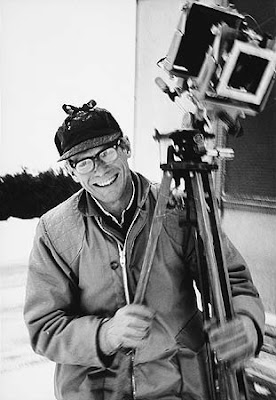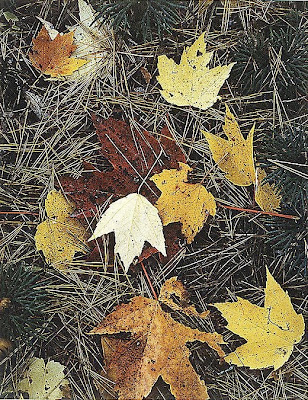Eliot Porter, Adirondack Mountains, New York, c. 1965
(Photograph by Patricia Caulfield)
(Photograph by Patricia Caulfield)
Under the onslaught of an anarchic flurry of breezes, aimless and particular, sun the color of milk leaks through the cloud-hangings. End of day. The right pertinacity of mayhem’s spry triggering of the revelatory gust. Seeing’s initial illimitable, the sheer blow of its bright namelessness, there in the chance molecular bump and grind. Fairfield Porter, out of a 10 December 1959 letter to Eliot Porter, photographer (and brother):
What color photography has that painting does not, is that it seems to have no laws—no laws are followed, but still everything by itself is ever so much more orderly than lawful art can achieve. It says that surrender and anarchy, if followed with the greatest scrupulousness, is safer that the carefullest government; that things are best taken care of by not trying. . . . It seems to mean that by the greatest attentiveness and by nothing else at all, you can discover that everything is the way it has to be. There is no improvement thinkable.Apt lines for talking about Eliot Porter’s photographs “illustrating Thoreau on the seasons” later collected under the Thoreavian title In Wildness Is the Preservation of the World (1962). Exemplary of the way a relentless taut antagonism is fructifying. Attending without attending. Dispersal (“wildness”) complicit with assemblage, its keeping. See the lines out of the end of John Cage’s 1959 “Lecture on Something” (silences marked by imprecise typographical gaps): “What is needed is irresponsibility. / Out of Meister Eckhart’s sermon, God made the poor for the rich, / I take the following : If, going to some place, we had / first to settle how to put the front foot down, we should never get there. / If the painter had to plan out every brush-mark before he made his / first he would not paint at all. . . .” And, at the end of “Lecture on Something,” Cage returning to Eckhart—for a “tonic and dominant / emphatic conclusion”—quotes the sentence beginning “Earth has no escape . . .”:
The masters say that all things are in travail, labouring to beget themselves in the image of the Father. They talk of earth as fleeing from the heavens; of her fleeing down and reaching heaven downwards; of her escaping upwards to encounter the lowest of the heavens. Earth has no escape from heaven: flee she up or flee she down heaven still invades her, energising her, fructifying her whether for her weal or for her woe. God treats man the same: weening to escape him we run into his arms, for all corners are exposed to him. God treats man the same: weening to escape him we run into his arms, for all corners are exposed to him. God will give birth to his Son in thee whether thou like it or loathe it; whether thou sleepest or wakest God goes on with his work. That we have no sense of it is because our tongue is furred with the slime of creatures and possesses not the salt of divine affection. If we had godly love we should savour God and all the works God ever wrought and receive all things from God and be doing the same work as he does . . .Apprehension by way negation, order’s fine savourable tumult in a prelapsarian—and prelingual (if one jockeys the metaphorical “tongue . . . furred with the slime of creatures”) state. Fairfield Porter begins the essay “The Immediacy of Experience” (1960) thus:
Hölderlin’s poem, Nature and Art, characterizes the Golden Age as a time when the ruler of heaven and earth “uttered no command, and still not / One of the mortals by name had named him.” (Vernon Watkins’ translation.) In the Saturnian age the world appeared new: things had no names, there was no past or future, all concepts were unconscious, and all order. . . .That “namelessness”—the unmediated soak of the world—is what Porter claims for photography (and, oddly enough, poetry): “An expression of the immediacy of experience—for what else is the namelessness of everything—is proper to poetry and natural to photography.” (See, too, Porter’s insisting that “Drawing and painting have a language, but literature and photography are language.”) As if it’s only in the antic excess and moot failure of naming that art matches nature. (Porter, talking in the 1959 letter to Eliot Porter about the color of “a weathered board” in one of Porter’s photographs: “grey . . . which turns out to be a sort of hesitant lavender, as though the camera broke down; as though grey did not exist and there is an attempt to find an inept substitute.”) And, of a photograph of trees in the snow:
All those twigs don’t have any disorder in them, but in their perfect distinctness, and because of it, and because nothing is left out, without trying at all, they are demonstrated to be more “designed” than an artist or scientist could ever see; and they have more variety. It disproves that nature is chaotic and art orderly. Art does establish an order; but this shows that the order of art is limited.At the end of “The Immediacy of Experience” Porter writes:
Photography is nature,* and so critics have thought it was not art. But if these photographs did not show you what they did, you would never have been able to discover it. The golden age of the child’s omnipotence is succeeded by the Jovian world of adults and of art. Adults classify, generalize and ignore. But the ability to distinguish comes first. Can we as adults be sure that we see more deeply, through art, than the photographer who pretends to do nothing but pay the closest possible attention to everything? He distinguishes endlessly and he dares not ignore. What does love come from if not just this scrupulous respect and close attention? The trouble with art is that, in choosing, the artist ignores. The trouble with the realistic artist is that he is indirect, and between himself and his experience he puts concepts: a steely equality of detail, conceptualistic anatomy, or the métier of the old masters. The non-objective artist is closer to the photographer in his reliance on direct experience. But, because he is not interested in objective nature he tends to lose his contact with concrete variety. The trouble with this is that it leads to a loss of a feeling for pluralism, as though all experience were becoming one experience, the experience of everything.To distinguish endlessly and refuse to classify and to dare ignore nothing. Like those breezes, dropped now, along with the whey-colored sun, “aimless and particular,” glomming the all like a wearable glove.**





